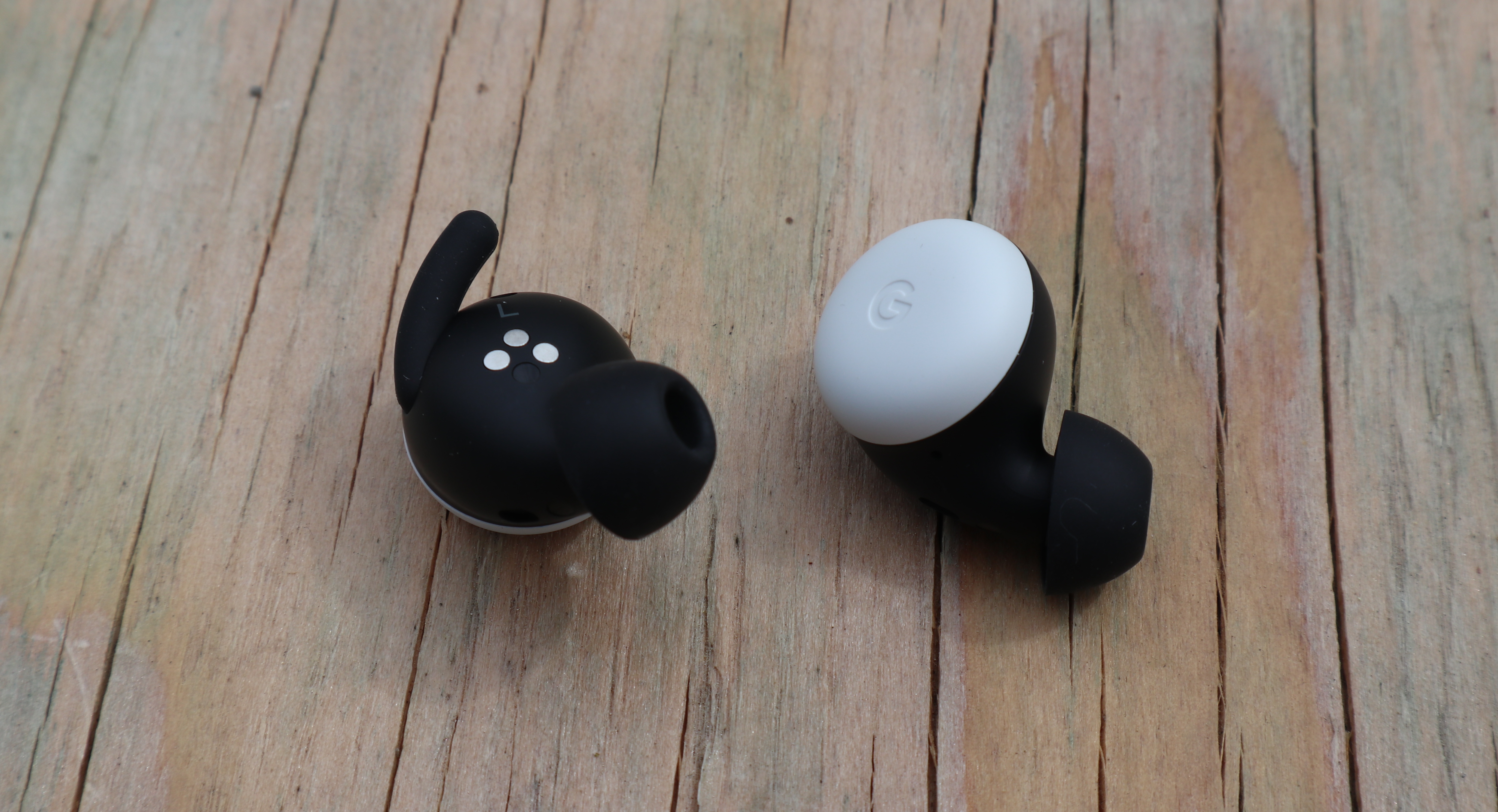
Sam Machkovech
Pixel Buds 2 review: These earbuds are “much better than OK,” Google
Enough quality, comfort, style, and usefulness to merit a $180 price—just barely.
by Sam MachkovechThe 2017 Pixel Buds were one of Google's worst hardware launches in the company's history. Really, these things were an utter nightmare. Their sound quality, feature set, awkward fit, and finicky case might have been tolerable as a free pair of buds included with a Google-branded phone—but not a standalone $160 purchase.
Any hardware refresh had enough work to do to catch up to 2017's standard of quality and convenience, but Google put itself into a deeper hole by launching this month's Pixel Buds 2 nearly three years later. Lucky for us, the company's new Buds, priced at $180, have turned out to be real buds. As in, buddies, homies, the kind I wanna lug around with me on a regular basis.
Google needed some good hardware news right about now, and that news comes in the form of Pixel Buds 2: a solid, competitive option for everyday earbuds in the year 2020. "Competitive" does not mean "perfect," but it does mean they're worth considering next time you think about buying earbuds.
Caveats and equipment
Before we dive in, I'd like to offer my usual "audio is tough to review" caveats. Ars Technica is not a dedicated audio-review site, due in part to the field's highly subjective nature, and that goes triply for devices that slide into an ear canal; one person's perfect fit is another person's utter annoyance. Still, I've been reviewing audio hardware for years at Ars Technica with aims to be as transparent about my opinions and testing methods as possible so that you can triangulate how your aural opinions might line up.
Additionally, while preparing this review, I tested other major modern Bluetooth earbud options, including the Jabra Elite Active 75t, the Beats Powerbeats Pro, Jaybird Vista, Sony WF-1000XM3, and Apple Airpods Pro. All of these, along with Pixel Buds 2, have a charging carrying case in common, along with wireless Bluetooth functionality as your only connectivity option.
I did all of my testing on my personal smartphone: a Samsung Galaxy S9. It has a 3.5mm headphone jack as driven by a high-quality DAC, which is a big reason I favor this phone. But while I prefer a hearty pair of wired cans when I want to take in every piece of the aural picture, I'll admit that convenient, high-quality Bluetooth earbuds have a place in my regular audio diet.
Cool? Cool. Let's jam.
Case, fit, and the beginning of many Airpod comparisons
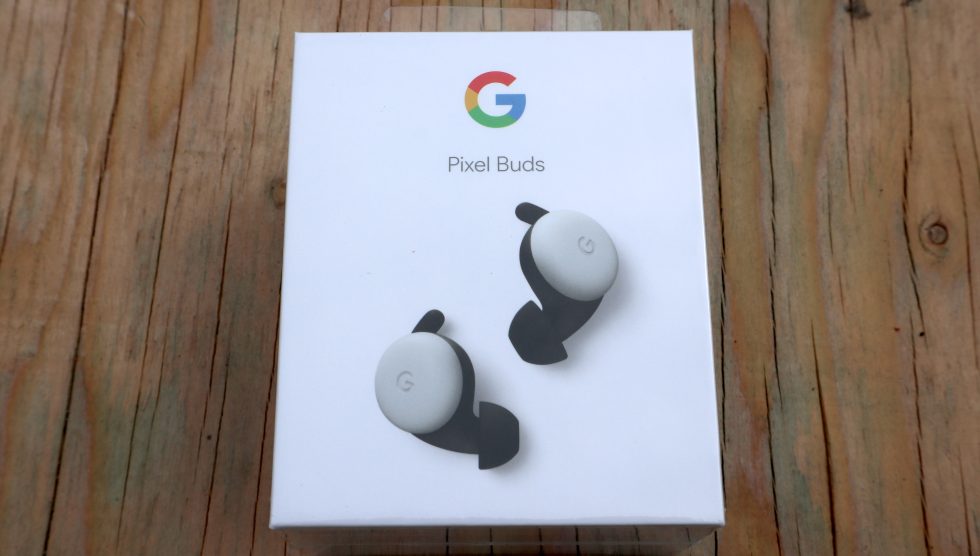
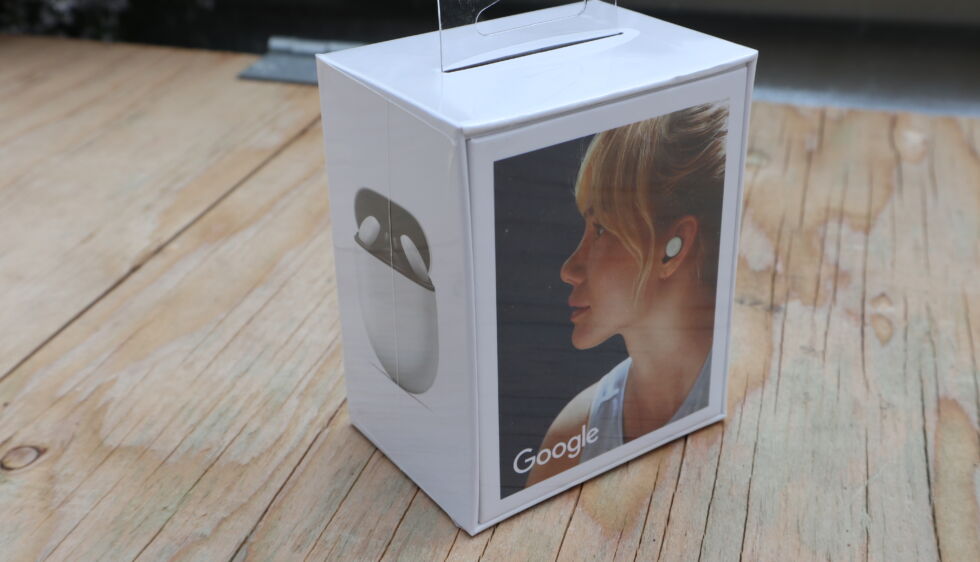
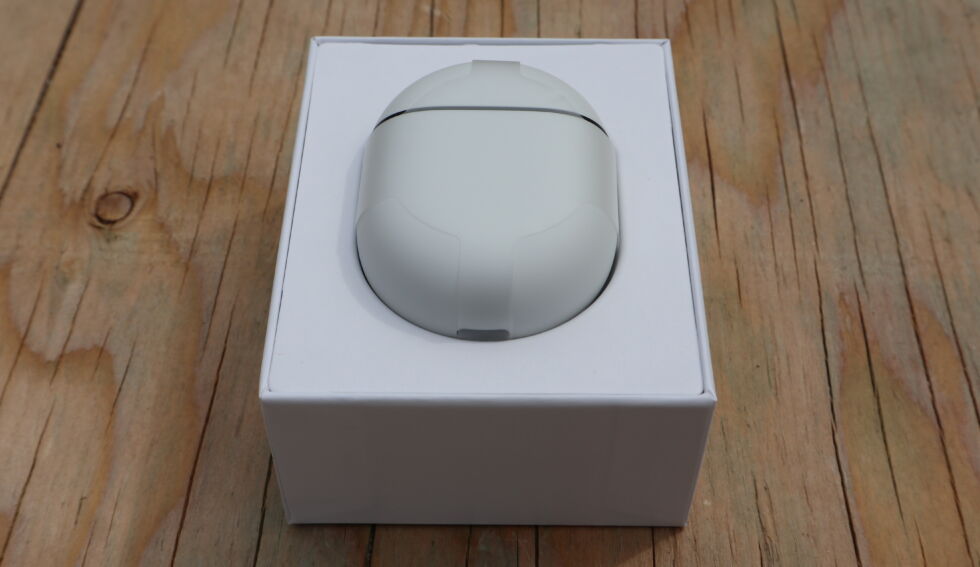
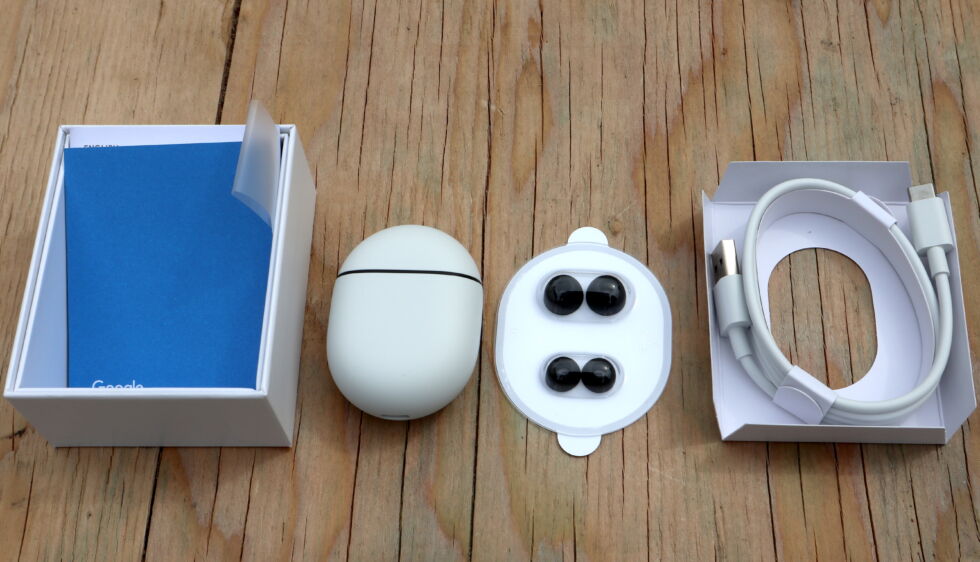
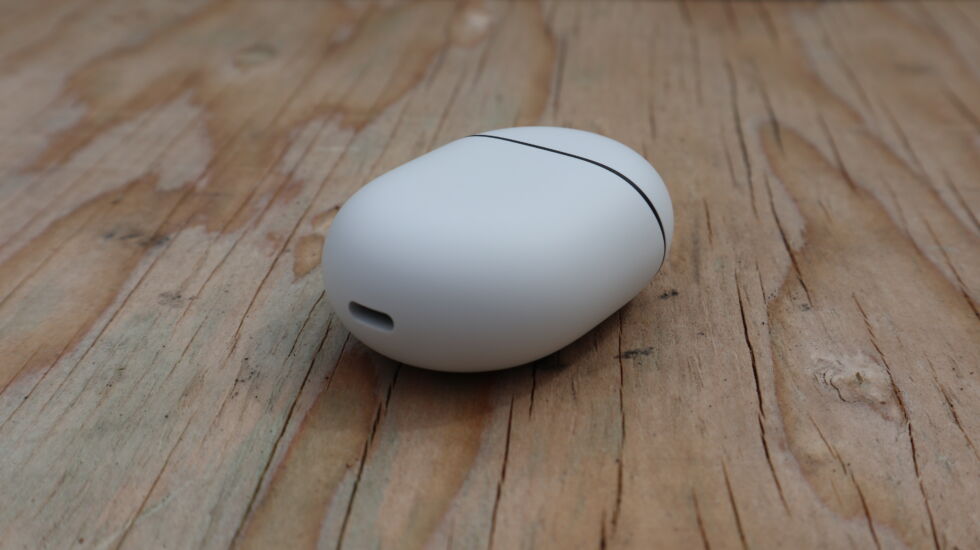
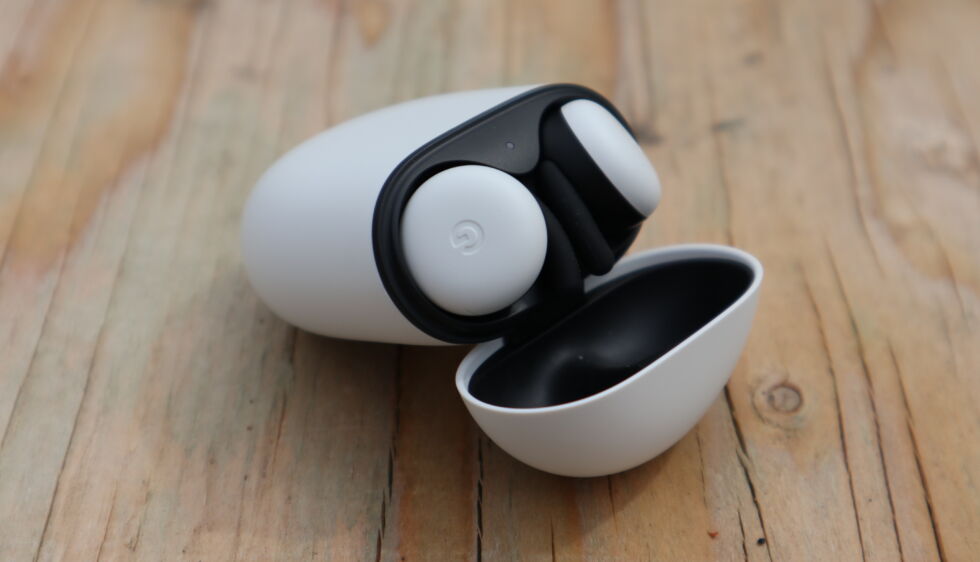
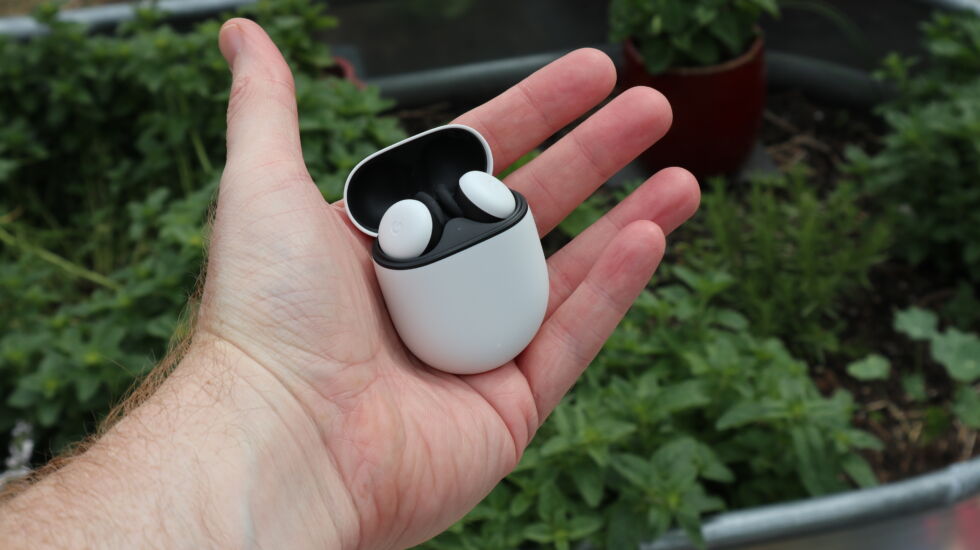
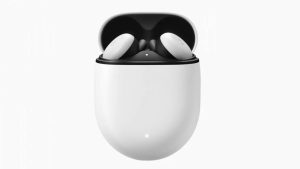
Google Pixel Buds (2nd gen)
Buy Now $179 at B&H$179 at Walmart$180 at Best Buy (Ars Technica may earn compensation for sales from links on this post through affiliate programs.) Pixel Buds 2 waste no time inviting a comparison to Apple's Airpods line. The launch model comes in a tone of white that's almost a Pantone-perfect match for Apple's. Their carrying case is nigh-identical in terms of dimensions: 63×47×25mm (2.48×1.85×0.98 inches). Its case is a hair bigger than Apple's Airpods Pro case in each of those dimensions, but the total size is possibly identical, owing to Google's new case having much rounder top and bottom edges.
As a result, Google already pulls ahead of the competition with the best earbud case we've seen thus far. Its matte finish is more handsome as a practical, handheld case than Apple's glossy, finger-smudged finish; the latter looks like an old iPod in comparison. Google's noticeably smoother edges feel better to either cradle in your hand or to tuck into a pocket. And if you've seen video coverage of Pixel Buds 2 thus far, you've seen—and heard—people repeatedly open and shut the case for a reason. Mmm. Whoever set the magnets and the carving of this plastic pattern knew what they were doing, in terms of the speed, the magnetic clasping, and even how the click sounds when this opens and shuts. The lead designers on that team deserve a raise before they're poached, Google.
Outside of their case, the Pixel Buds 2 are, like their predecessors, designed differently from most competitors. Though this time, that's not a terrible thing. (Seriously, Google, who thought itchy expandable nylon straps through the ear canal was a good idea?)
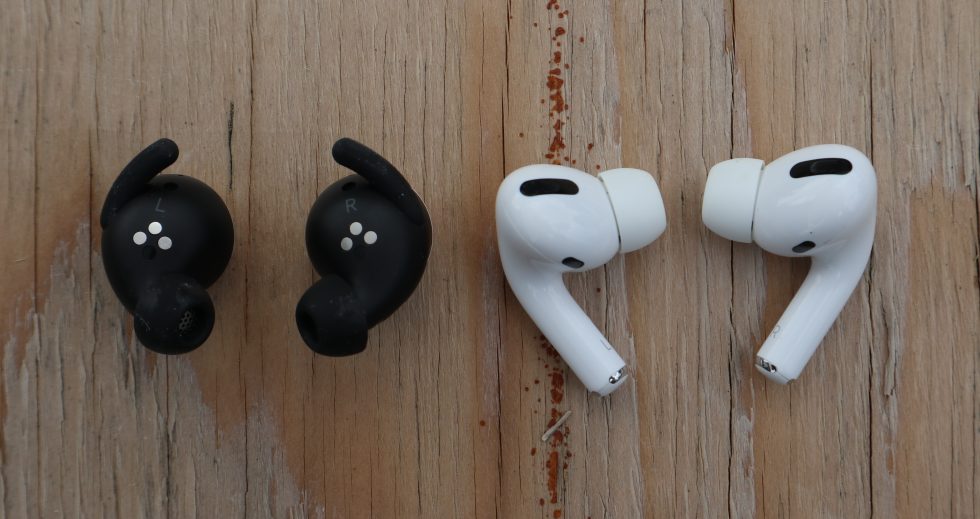
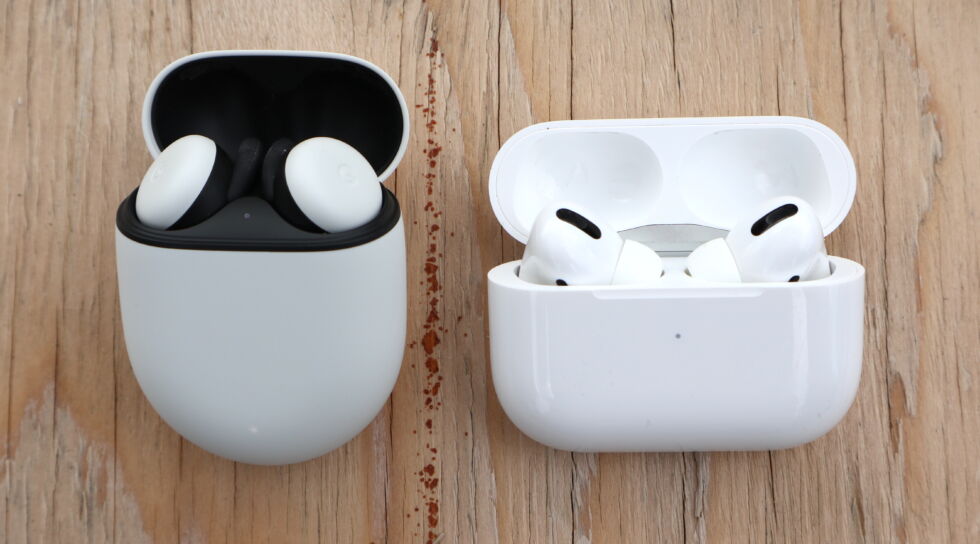
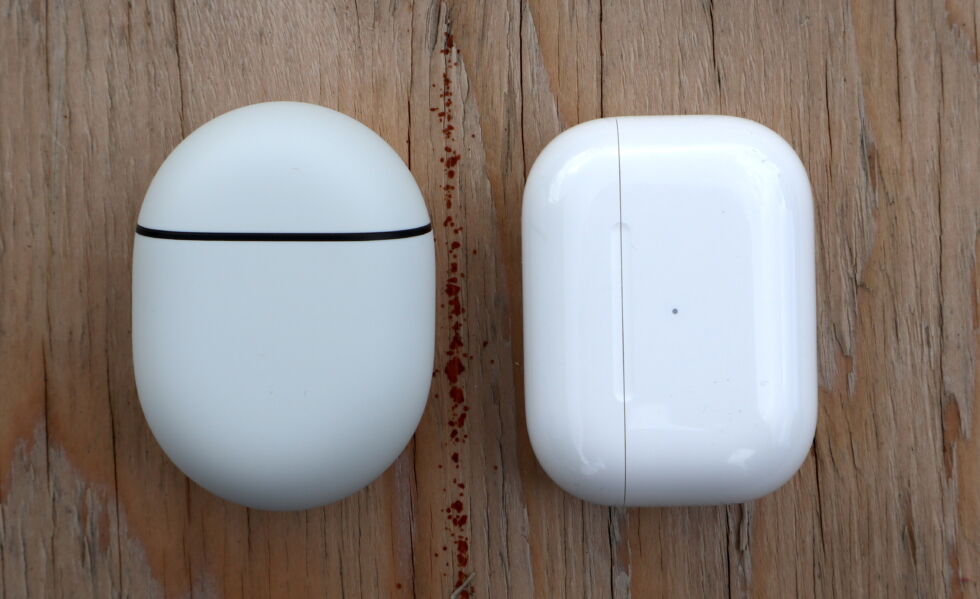
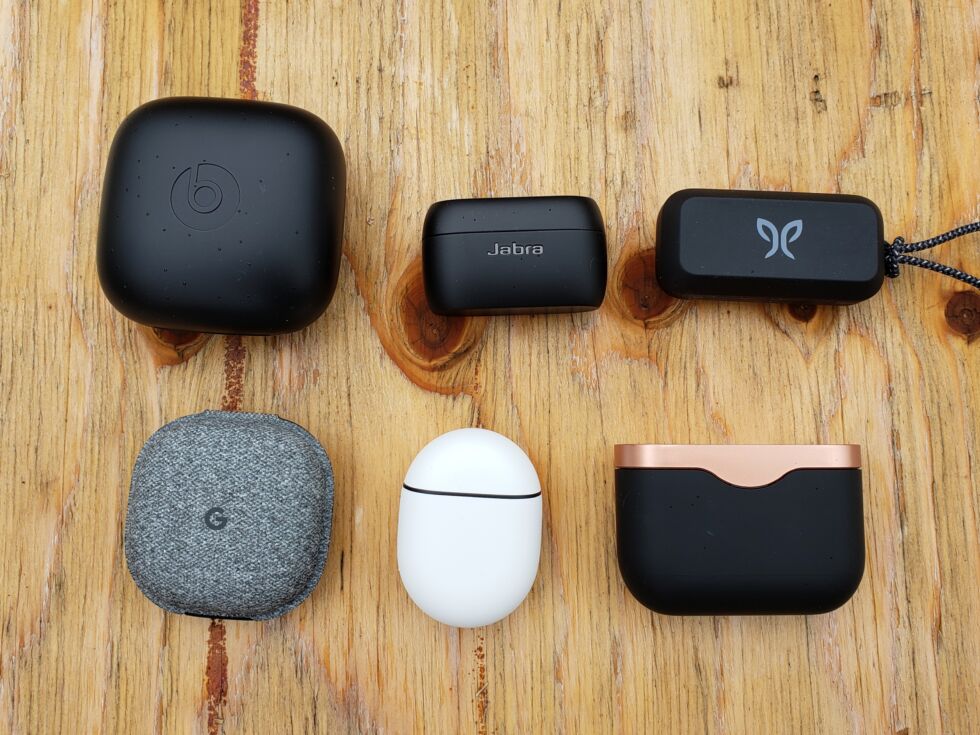
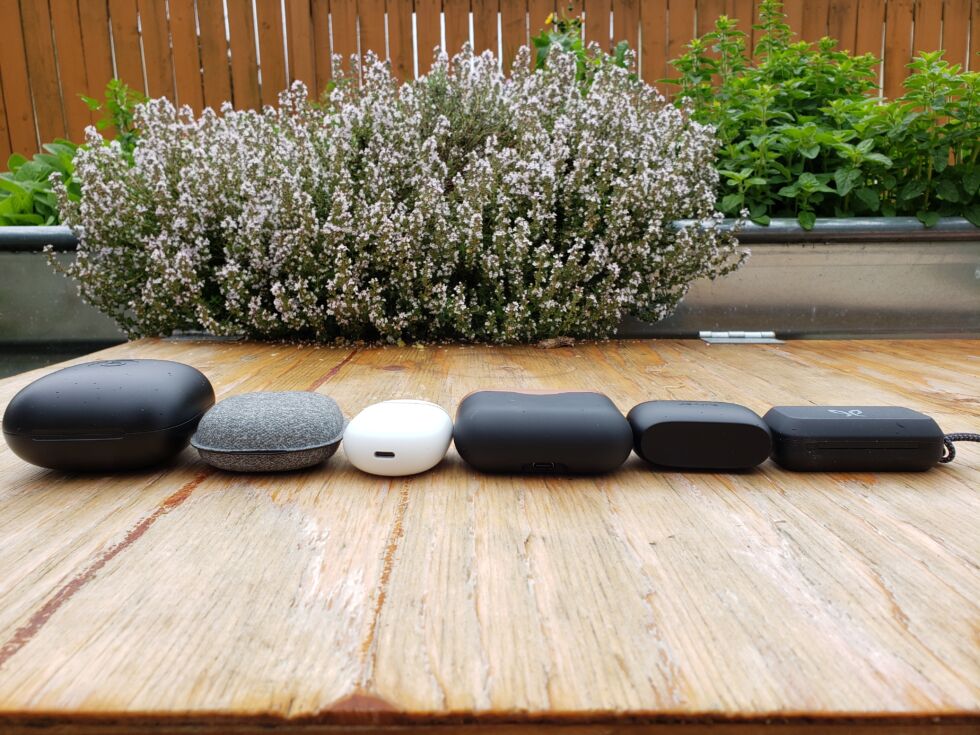
The Pixel Buds 2 shift from a hard plastic earpiece to a rubberized tip, meant to insert directly into your ear canal, much like how the Airpods Pro did compared to its predecessors. You get three size options for these tips. Unlike most of its major competitors, Google is still married to this idea of a secondary bracing point for your ear, so the Pixel Buds 2 also include small rubber "wings." Personally, I am fine with these, because they do two crucial things: they take a tiny percentage of earbud bracing out of your ear canal (and every smidge of assist there helps), and they help users feel the bracing point required to get the Pixel Buds 2 to their maximum audio-quality level.
Sound quality: The bass is the base
Earbuds can only do so much in terms of punchy bass resonance, and like some of the boomier earbuds on the market, the Pixel Buds 2 distribute their lows outside of the rubber-tip portion. But at their worst, earbuds can crank their bass too far, to the point where you need to go into a manufacturer's official app and play with an equalizer to undo the default BWOMP BWOMP effect.
Pixel Buds 2 opt for a noticeable-yet-subtle spread of bass through the ear canal. You won't truly appreciate this effect until you twist your earbuds such that the rubberized fin locks into place. And Google loses points by not clearly demonstrating this to users in the setup process. The official Pixel Buds app mentions this twist-to-fit feature and suggests users rock the Pixel Buds 2 back and forth until the fit is just right, but there's no way to really confirm that the fit is just so with a lot of typical music. Put on a catchy song—one whose bass you might otherwise ignore—and you'll hear the highs and mids come through in impressive fashion and assume you're done.
Google's official app would greatly benefit from a bass-heavy sample app to help new users understand the difference a proper fit makes. I suggest that new users put on a melodic hip-hop track with some sort of dominant tune and high-end ring of percussion throughout, then notice the punch of whatever bass comes thumping in on the beat; a melodic bass line demonstrates this better than a plain ol' thump-thump-thump option. (Some suggestions: "Piku" by the Chemical Brothers, or "Thieves!" by Run the Jewels.)
Time and time again, I kept coming back to an amazing demo song for the Pixel Buds 2: "BFG Division" from the Doom 2016 video game soundtrack. With Google's buds inserted properly, this track put me into a pumped-up workout rage. The instrumental song begins with a thudding swell of bass beneath a tap-tap-tap of high-pitched beeps. Then some industrially augmented guitar snarls and ominous synth pads set the tone of crushing metal to come, and at the 1:02 mark, this song's version of "the drop" includes some twinkling computerized notes before a wall of rock blows over.
After noticing how much this song rocked me on the Pixel Buds 2, I went through every listed earbud above to see how each fared. The Jabra Elite Active 75ts were a little too boomy. The Airpods Pro were a little too anemic. The Sony WF-1000XM3s came closest, with better straight-into-the-canal drivers that brought out more high-end clarity, particularly in the constant din of the high-hat during the loudest parts. But the Pixel Buds 2 nail this song's most impressive trick: the frequency-trickery WHOOSH that repeats over and over during the "chorus" riff, where a mild drop-out of drums and a "dunnh-nunna-nuh" of guitar repeatedly explode in a snare-cymbal-thump pop. This exact pop consistently earns a bang of my head and a pump of my fist.
Killer audio... in ideal circumstances
I'm the kind of music listener who obsesses over perfectly nailed synesthesia (you can see me wax poetically about this in my Tetris Effect game review, among other Ars pieces), and this moment in "BFG Division" would be spoiled by any fake-sounding carving of frequencies or inadequate audio drivers. Out of my roster of tested earbuds, only the Pixel Buds 2 consistently nailed this effect.
The same goes for every other genre of music I tested (here, enjoy a Spotify playlist of my preferred testing selections). Sony's earbuds always came out mildly better in terms of clear frequency separation. Apple's earbuds always sounded "good enough"—clear, balanced, and comfortable, with mild-but-appreciable bass. And Google's earbuds always felt like the "one higher" option, delivering artists' and recording engineers' original sonic intent for the entirety of a given song.
But that's assuming you're in an ideal environment, which Pixel Buds 2 can lose points on in two ways.
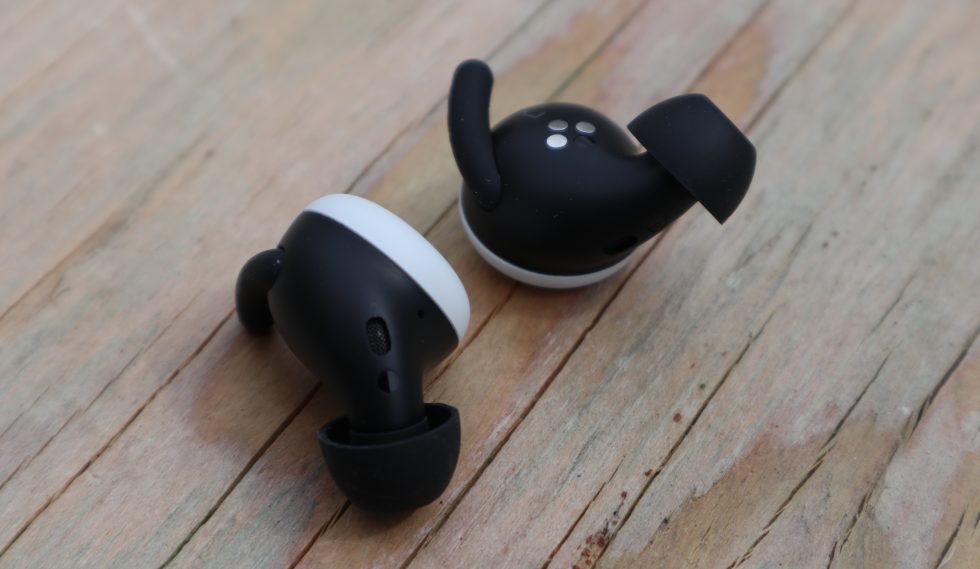
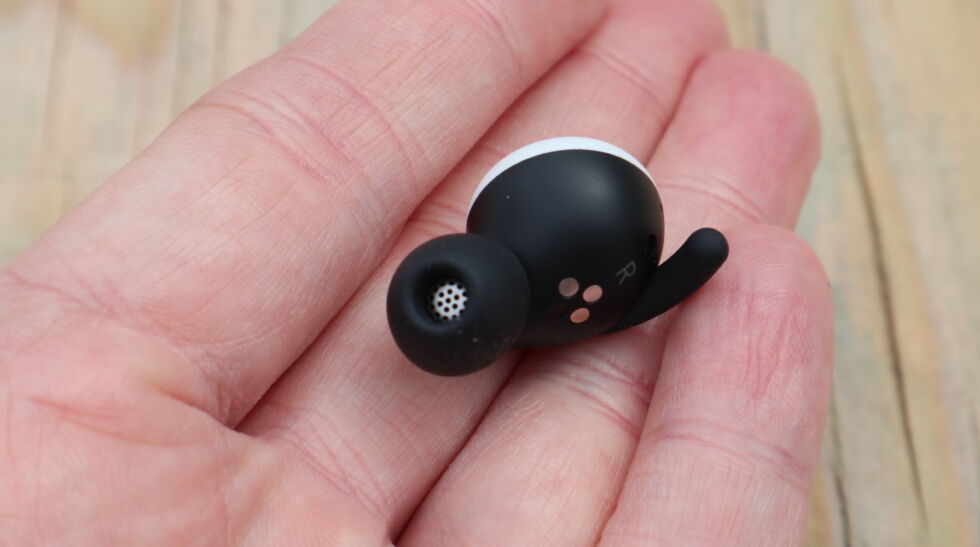
First, you must situate Pixel Buds 2's little wings just right to enjoy this balanced-bass impact. In my week of testing, I was able to guarantee a comfortable, fixed fit during milder activities: working from home, walking (with a mask on) around my neighborhood, and hitching a car ride (with a mask on and a driver in my current "trusted" circle). The exception came while working out, which for me as of late is a mix of dumbbells, yoga poses, calisthenics, and careful jogs through wide side streets. (By the way, gosh, I wonder how well this article will age.)
I am, without a doubt, Ars Technica's sweatiest staffer. (Don't ask how I figured that one out.) After only a few minutes of activity, my body starts dumping sweat, which means, among other things, I have to strip down as soon as I start playing high-impact VR games like Beat Saber. Any earbud that becomes uncomfortable during a sweat-dumping workout is a deal breaker. In good news, Pixel Buds 2 stay put while I work out—and arguably more so than my previous pick for a sweat-friendly earbud, the Apple Airpods Pro, which rely entirely on a single, specially shaped rubberized tip per ear. Neither slips out of my ear after getting lubed up by my drenched reams of sweat, but Pixel Buds 2's wings are another "one higher" variable to consider in that use case.
However, I've yet to find an earbud that automatically drains any sweat buildup between my ear's skin and my earbuds; they all have to come out for a shake-and-wipe every 10 minutes into my sweatiest routines. And in Pixel Buds 2's case, once I'm sweaty, I have to repeatedly check the wings' seal to return to ideal bass performance. They'll still sound good, but if I want to guarantee a "raaaarrgh," pumped-up sensation in a song near the end of my workout, I have to remove and wipe each ear every four minutes.
What’d you say, sonny?
Second, Pixel Buds 2 do not include an active noise-cancellation feature, so your total listening experience will vary depending on your environment. Pixel Buds 2 seal pretty well in the ear, owing to their wing-based construction, so medium-volume music will sound fine in lower-volume environments, and loud music will do great anywhere. But even the mildest noise-canceling earbuds surpass Google's option when walking down a noisy street or enduring the ever-present din of an airplane (which I had to simulate using speakers in my home office).
I've personally yet to test noise-canceling earbuds that surpass over-ear headphones released in the same year, so I don't prioritize noise cancellation in my own earbud use. But earbuds are getting better at this trick in many other manufacturers' lineups, so I wouldn't blame you for calling that a deal breaker in terms of a $180 pair of earbuds in 2020.
Additionally, there's no way to enable a form of "pass-through audio" for Pixel Buds 2, which most other modern earbud options include as a default. If I wear Pixel Buds 2 while picking up a takeout order at a neighborhood bakery or restaurant, and I want to chat with the clerk for a minute while standing outside, I run into this issue roughly half the time: the Pixel Buds 2 obscure just enough outside noise that I find myself mishearing the other person within 20 seconds. That's not ideal for a brief, polite exchange. As a result, I either remove Google's earbuds outright or twist them within my ear so that the wings are dislodged. The latter is quite uncomfortable after only a few seconds, so I typically find myself popping an earbud out—not ideal for tiny, expensive earbuds.
While I'm on the subject: Pixel Buds 2 include an "adaptive sound" option, which Google describes as "subtly and automatically optimiz[ing] volume based on the noise level of your environment." Subtle my tuchus. If I walk down the street and a single loud truck zooms past with this function enabled, Pixel Buds 2 wait a full second to react by cranking my volume as if I'd tapped the "volume-up" button twice. It's jarring, it always comes too late, and then it takes too long to drop back down. I'll wait for Google to retune this feature before I even think of enabling it again.
Comfort, battery, and microphones
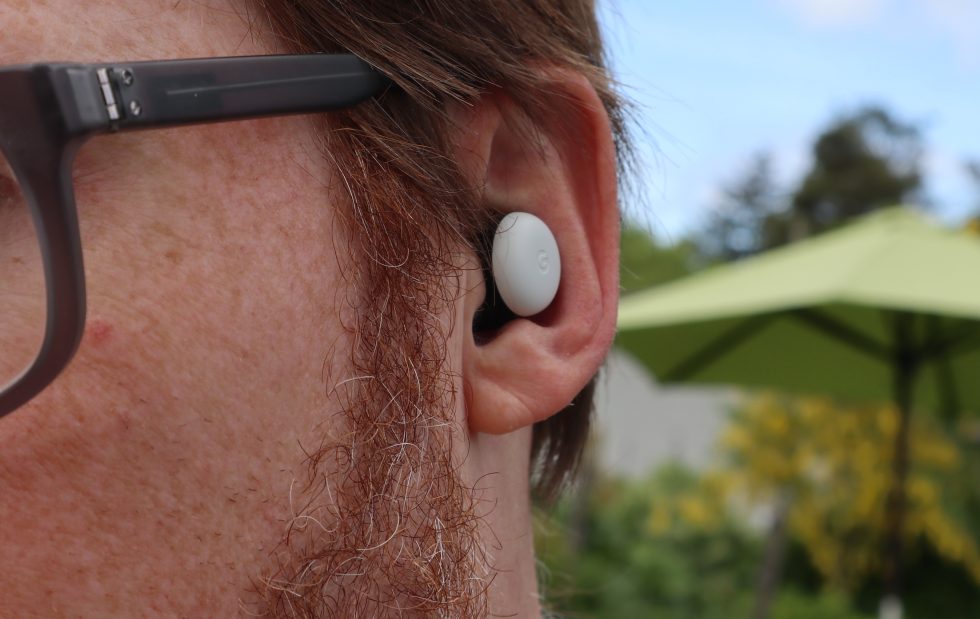
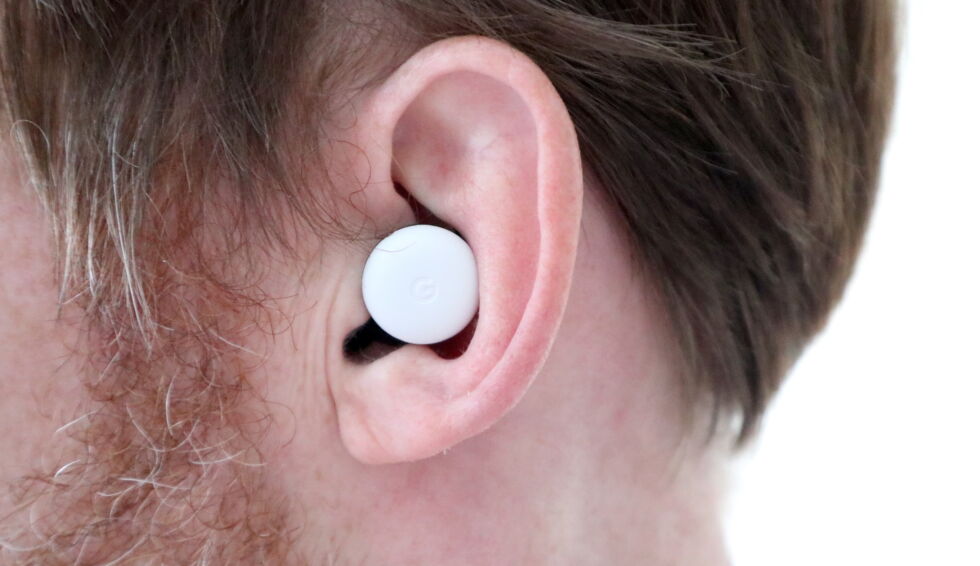
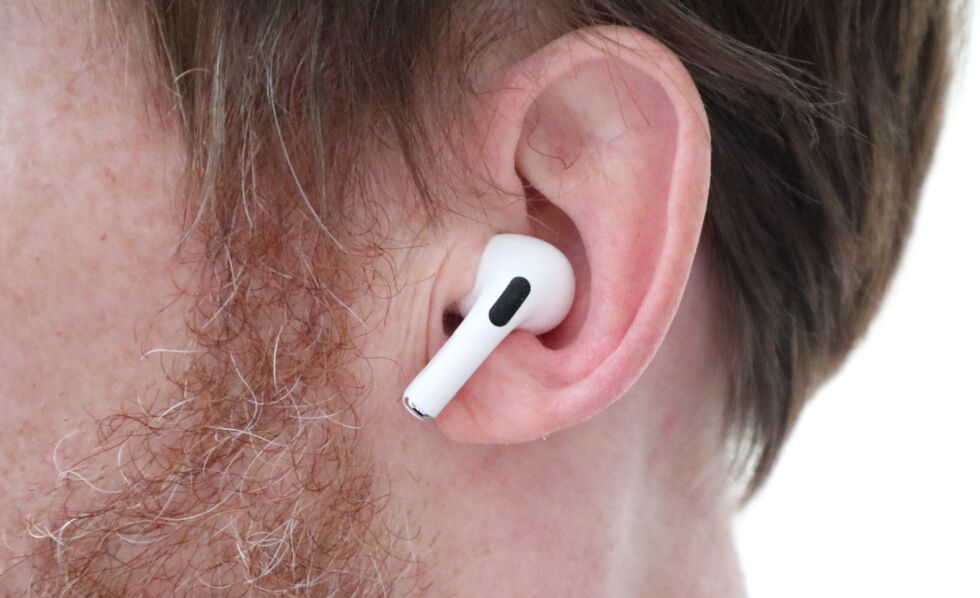
In terms of long-term comfort, I began my tests unsure whether the Pixel Buds 2 were ideal for my preferences. But after two full days of testing, the mild discomfort I felt from their specific fit faded away. I'm typing this nine days into my testing, and I've reached a point where I can leave them in for their rated five-hour battery life and feel pretty much the same as I do with any other comfortable earbuds I own (particularly Koss' line, which is still my gold standard for comfort and fit). No matter how they're constructed, buds are foreign objects in your ears and are nice to remove every few hours, but the Pixel Buds 2 are otherwise not oppressive, itchy, or painful. And no, they never feel like they're about to fall out.
Comparatively, the Airpods Pro rank mildly higher in terms of comfort—especially since they don't require any twisting to get into their "ideal" fit state—while I burnt through five out of the seven included ear-tip pieces that come with the Sony WF-1000XM3 in search of a comfortable fit. Even once I found their best mix of sound quality and tight fit, I found myself noticing and disliking their tightness within seconds of each use—a sensation I've never really gotten used to.
Like most other modern earbuds, Pixel Buds 2 drain battery when they're left out of their charging case, and this is a good motivator to regularly put them into their satisfyingly clicky, egg-like home. They run at lower power while out of your ears and not playing audio, and they have a handy "don't play audio when they're not in my ears" feature, enabled by a new sensor. That standby time is only about 12 hours (which will become relevant in a bit), compared to roughly five hours of active music- or podcast-listening time. Google's earbuds pop into and out of their case easily enough, thanks to a firm-yet-loose magnetic system, and their fast-charge promise is no joke: 10 minutes in their little egg will indeed charge to roughly 100 minutes of listening time.
Figuring out exactly how good your favorite Bluetooth earbuds' microphones will sound in audio and video calls can be tricky, owing to many Android recording apps relying on a phone's built-in microphone array. By using a freeware Bluetooth-specific app, I confirmed what I suspected: Pixel Buds 2 don't magically improve recording quality, instead hovering neck and neck with the competition. The results seemed a smidgen ahead of Airpods Pro but not enough to where I'd recommend one over the other in that metric. Ultimately, if you want to sound good while calling someone on your smartphone, none of the earbuds I tested hold a candle to a dedicated microphone that hovers close to your mouth. (You know, like the ones you'll find on 3.5mm-compatible headsets.)
Touch-sensitive bulbs, included app
The last thing to review is Pixel Buds 2's touch-control system, which was easily the best aspect of Google's first Buds, and its return is welcome. The touch controls have improved over last time, but they're still not perfect.
Many earbuds ask users to click into a firm button, which usually jams their plastic bodies further into your ear canal. This is absolutely a deal breaker for me—truly, the reason you'll never see me purchase push-button models from Jabra, Jaybird, and Beats. Pixel Buds 2, conversely, ask you to tap, swipe, or hold a finger on their touch-sensitive bulbs. These bulbs, which hover in the ear canal, are nearly identical in size to the last ones: at a finger-friendly diameter of 0.77 inches (19.5mm).
Freak disconnects
During my first nine days of testing, I ran into two partial or total disconnects. The first happened while I was jogging without the Pixel Buds 2's case, at which point connectivity repeatedly turned off and on and off and on. Returning them to their case fixed this.
The second time, I took the Buds out of their case while music was playing from my phone's speakers. Only one Pixel Bud 2 would turn on, and this persisted until I unpaired the entire headset, power-cycled the phone, and paired them again. We didn't find reports about either of these issues at other sites, and our review pair otherwise did a bang-up job of syncing with my phone no matter how many different earbud pairs I switched between.
Finger recognition is absolutely improved since last time, as is the earbuds' ability to differentiate between taps and swipes. If you're sitting still and need to play/pause (tap), skip ahead (tap twice), rewind (tap three times), adjust volume (swipe forward for more, backward for less), or bring up Google Assistant (hold your finger until you hear a tone, then either speak a command or let go to hear notifications), all of these work as you'd expect.
I can't say the same for trying these maneuvers when you're walking briskly or jogging, on the other hand. The bulbs' diameter is just small enough to make accurate tapping placement a bit tricky when they become moving targets. Worse, any dreams of accessing Google Assistant with sweaty ears and fingers is an utterly lost cause; the required press-and-hold is a nightmare with sweat in the picture.
One solution to this issue might be tap customization—especially since Pixel Buds 2 feature touch controls on both ears this time, compared to a single ear in the original model. However, as of press time, Google has opted to duplicate the same commands for both ears and deny any discrete customization control. I appreciate Google making its touch controls identical across both ears by default; figuring out Sony's spread of controls across both WF-1000XM3s was a pain in the butt as a new user. But denying any additional options to picky users is ridiculous, especially for earbuds that come with their own dedicated app.
Really, the Pixel Buds app is a snoozer. Its best toggle as of press time is a "find device" toggle, which makes each Pixel Bud 2 ring in case you've dropped or lost either. (At least, so long as you haven't exceeded their aforementioned 12-hour standby time.) Otherwise, the app controls the Buds' Adaptive Sound option (remember: it stinks, turn it off), lets you disable the handy in-ear detection system (remember: it's great, leave it on), confirms each earbud's battery level, and explains how the touch panel works if you've forgotten. You won't find an equalizer or any other customization options here.
Wake in the morning feelin’ like Pixel Diddy
Personally, I steer clear of equalizer options on any audio device. I'm one of those weird sticklers for listening to music the way artists and producers delivered it, even if that comes at the cost of sounding "flat" compared to what you might get out of an equalizer. I'll always err on the side of ponying up for better audio hardware to improve everything I listen to across the board, as opposed to an equalizer I have to fiddle with as I hop from genre to genre.
Unlike the original Pixel Buds, which engaged in automatic frequency-tweaking tomfoolery, Pixel Buds 2 either don't need such a poor-sounding gimmick or do it so masterfully that I've never noticed. Either way, my massive music-testing library, which ranges from fields of static noise and ambient warbling to delicately finger-picked guitar as well as from critically acclaimed '60s hard-bop jazz to the stupidest party jams ever written by Kesha, always compared favorably on Pixel Buds 2 to my favorite bookshelf speakers and favorite wired headphones.
As a result, every time I glance at my earbud shelf, covered in seven options, I keep instinctively reaching for Pixel Buds 2 before taking my music or podcasts on the go. That being said, I'm the kind of user who's willing to contend with Pixel Buds 2's clear failings compared to the competition: a total lack of noise cancellation and pass-through audio options, and the need to frequently check the earbuds' fit to guarantee optimal sound quality. If either of those would annoy you in high-end earbuds, the Apple Airpods Pro will make you happier. For me, once I'm past the $100 mark for audio gear, sound quality is paramount—so long as the rest of the package is quality enough. For that reason, I'm swallowing Pixel Buds 2's biggest issues and sticking with them as my Bluetooth audio option for the foreseeable future.
The Good:
- Musical reproduction. Higher frequencies are the slightest bit diminished, yet overall impact is best-in-class.
- You'll love toting this comfortable, handsome, satisfyingly clicky charging case in your pocket.
- Snug, comfortable fit, once I got used to the rubber wing tips—and they stay put, even when drenched in sweat.
- Five hours of musical playback per recharge is enough for me, and the quick-recharge case works as advertised.
- The only good things from the first Pixel Buds, the touch-sensitive bulbs, return in improved fashion.
The Bad:
- No noise cancellation.
- No pass-through audio option.
- If the idea of fussing with rubber wings for optimal audio during sweaty workouts sounds annoying, these may not be for you.
- Five hours of musical playback per recharge may not be enough for you.
- Touch-sensitive bulbs are more finicky during sweaty workouts than I'd hoped.
The Ugly:
- Why can't we customize the tapping and swiping gestures, Google? What year is this?
Verdict: Google's latest stab at great earbuds for a wide audience is a surprising success. If you need Android earbuds and want to spend big, consider these strongly (but not universally) recommended.